Help rotations
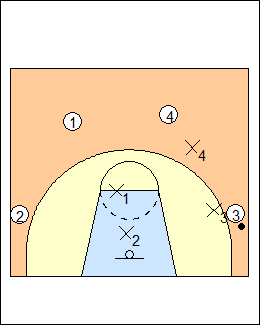 | 1 At any age level, defending dribble penetration is hard, especially if your team denies perimeter passes. When the on-ball defender gets beat, other defenders must rotate to cut off the drive and prevent easy passes to open attackers. Here attacker 3 has the ball on the wing, defenders X1 and X2 are in help positions since they are defending attackers who are two or more perimeter passes from the ball. Youth basketball rules may require that X1 and X2 be outside the 3-second area on the weakside. See Defending - 4 on 4 help rotations, 3 on 3 kick-out, Fratello 3 on 3 drive and kick, Pitt 4 on 4 penetration, Spurs shift and close, Wootten horseshoe, DeMatha shell, Calipari shell, Forcing left shell, Defences - Gap basics, Forcing left basics, Forcing left pack, Dave Smart weak-hand, Dave Smart rotations. |
 | 2 1) Baseline penetration If 3 drives baseline, offensively 2 sinks to the baseline on the weakside (baseline drive, baseline drift), 4 fills behind the drive, giving 3 a bail-out pass. 1 will stay at 45 degrees on the weakside (shown), or move above the ball (90 degrees). a) Trap Defensively, low weakside X2 rotates to cut off the drive and trap with X3, high weakside X1 covers down (drops) to take away an easy pass to 2, X4 stays with 4 to deny a pass to the fill behind. X2 is the helper, X1 helps the helper, getting down to ball level (the ball tells you where to play defence). In 5 on 5 with a low-post attacker, optionally his defender is not involved in help (stays with the low post), and help rotation is the same. To drill this help rotation, optionally replace 4 with an unguarded coach, who passes to 3. Billy Donovan - don't give a guard a bail-out pass to the wing, make him skip it, there is enough time to recover back to that. Hoop Tactics - if X3 is mismatched against 3, X2 leaves early (on the first bounce) and traps with X3. Ettore Messina - when the ball penetrates towards the baseline (by dribble or pass) help-side defenders must drop to the ball-line, diagonally to avoid being pinned behind an opponent. If 1 is a dangerous shooter, X1 drops toward the ball-line but stays in the passing lane, forcing 1 to move to get open. Too much dribble penetration is vulnerable to offensive rebounding. If a defender is late getting to the player with the ball, or there is no defender in the key, there is a problem with your defence. Bob Huggins - the 3-point shot changed the game, on dribble penetration, they used to help and recover in line, getting as deep as the ball, which allowed a direct kick-out pass but for a lower-percentage outside shot. However, now that shot is for 3 points, so help is in line with ball and man, not allowing a direct pass. Kevin Eastman - regular-season games are won by strong-side defence, championship games are won on the weakside. |
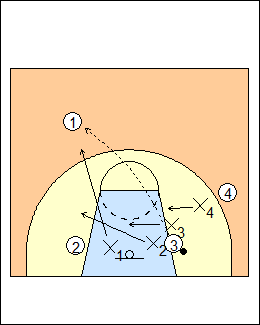 | 3 Rotations from help i) Help and recover All defenders recover to their own checks when 3 makes a pass. Basketball Australia - a potential problem is that 2 may be left temporarily unguarded for a layup. |
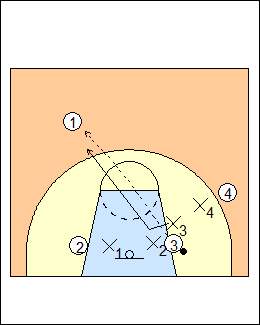 | 4 ii) Beaten defender has leftovers Help defender X2 stays with the ball (he's between the ball and the basket), beaten defender X3 rotates out to find the open attacker. Here cover-down defender X1 stays with 2 (who is close to the basket), so X3 takes 1. Basically X2 switched to 3 and X1 switched to 2 on the help rotation. Stuart Manwaring (FIBA Oceania) - when the ball is passed back outside, any defender who is between an attacker and the basket should stay with that player, the defender who is not rotates out. This allows the team to defend players closest to the basket. The low post defender never leaves his player. Basketball Australia - defenders who rotated to guard the penetration have switched, X2 is now guarding 3 and X1 is guarding 2 (switching rotation can lead to defensive mismatches). Rotation is the same with a post player, his defender has a no-help rule, staying with the post. See WABC Helping the Helper, Randy Sherman Baseline Push, Defending - 3 on 3 kick-out, Forcing left shell. Variation - X2 rotates out and has leftovers, X3 stays matched up (e.g. if 3 is the best offensive player), see Defending - Spurs shift and close, Pitt 4 on 4 penetration, Jr. NBA Fundamentals of Help the Helper, Hoop Tactics SOS Disruptions, Basketball Australia. |
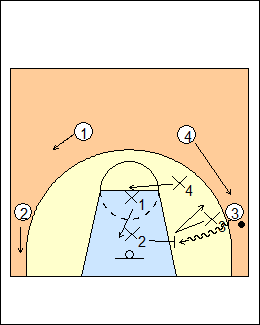 | 5 b) Run and jump X2 cuts off the drive and calls "switch", X1 covers down, X4 rotates to the top of the "i", X3 peels off to find an open attacker (in X4's direction), here 4 filling behind the drive. All four defenders should be matched up. If youth basketball rules do not allow intentional double-teams, X2 or X3 must rotate out when X2 cuts off the drive. Greg Francis - X2 helps only if he can read the number on 3's chest, calls "switch", top of the "i" X1 drops to the basket to make the drift pass more difficult, X4 rotates to the top of the "i" looking for cutters or ready to close out on a pass on the diagonal (international teams are very good at making that pass off the dribble), X3 on hearing the switch call peels off and looks for the next player in that direction. See Defending - Fratello 3 on 3 drive and kick. Allison McNeill - X2 meets 3 outside the lane, remaining players rotate, two defenders must form a "weakside i" in order to rotate out to the next pass using the closest-player rules. |
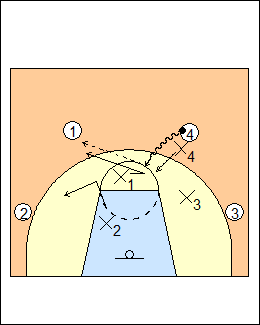 | 6 2) Middle penetration a) Help and recover Here X1 helps and recovers on a pass to 1, X2 stunts to help the helper. McNeill - on middle penetration, cut off the driver then recover quickly to your own, this is often a hedge-and-recover move. Kevin O'Neill - trap a baseline drive outside the paint, help and recover on other drives, not double-teaming, it's always one-pass help, if help has to come from two passes away there's a wide-open three or a dunk. coachesclipboard.ca - teams may choose to attack middle penetration and rotate similar to how they handle baseline penetration, or hedge and recover to slow down the penetrator and allow time for the defender to recover. Dave Smart - every time the ball is put on the floor you're bluffing or helping; on short closeouts, 95% of the time it should be a bluff. |
 | 7 b) Help rotation A help rotation may be needed. Here 4 passes to and corner cuts, clearing out gap defender X4. |
 | 8 With 1 spaced away, or if X1 loses vision, X1 cuts off the drive, - calls "switch", X2 rotates to 1 and X3 peels off to take 2, - X1 and X3 peel switch, - or X3 traps with X1, X2 has first pass, X3 has leftovers. If X2 helps on the drive and X1 covers down, 1 may be wide open. Dave Smart - the guy who helps calls help if he needs help, when he's too far away from his guy. Ernie Woods - high weakside X1 stops middle penetration, if a low defender steps up it creates an easy passing lane to his man. Mike MacKay - the three-player rotation is difficult if 1 rotates behind the drive, it may be better to switch X1 and X3. Francis - when you help off the help side on middle penetration, it's a very easy pass for most players if the offence maintains good spacing, and it creates a scramble situation to recover on a quick pass-pass (here 3-1-2). X1 calls switch if help is required on the drive, X2 covers first pass, X4 has second pass, and X3 drops to cover 4 in the corner (a four-man rotation). WABC Middle penetration - help must come from below the ball, if X1 is above the line of the ball, X2 helps and double teams with X3, X1 drops and takes first pass to 1 or 2, X2 stays with 3. Hoop Tactics SOS Basic Concepts - if 3 penetrates to the free-throw line area, high "i" defender X1 makes a "cross switch" with X3. Basketball Australia - whether the ball is forced sideline-baseline or to the middle of the floor, help usually comes from the split line and from below the ball, closer to the baseline. Randy Sherman Middle Penetration - options on middle penetration are a) trap (the helper rotates out and has leftovers), b) fly switch (with the helper), c) plug (help and recover).  |
This page was made with Basketball playbook from Jes-Soft